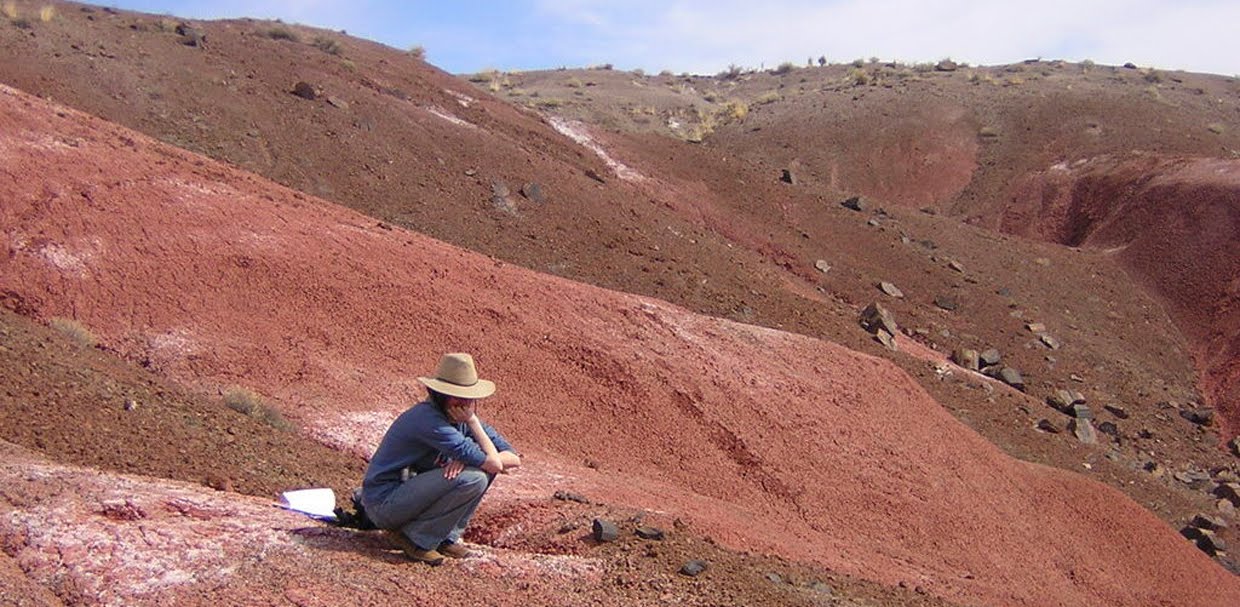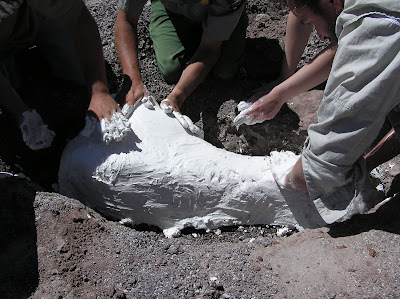This is the piece of bone. Bone looks different depending where you are, but the pieces here often have a blue cast to them, and they definitely break differently than petrified wood or sandstone do. The best way to tell bone is to examine it closely and see if any of it looks spongy, as the inner part will. At least, that works with animals that don't have hollow bones. Also—I am not kidding—you can try licking it. Fossil bone will often stick slightly to your tongue. Try it by licking your computer monitor.
Last week we went out to try to locate a site excavated in the 40s by the late great paleontologist Edwin Colbert. He'd gotten a phytosaur skull there, and knowing exactly where it was would help us figure out the biostratigraphy of the area, or which life forms were present during which rock (and thus time) intervals. We had old color photos and a dot on a map. Unfortunately, nothing anywhere near the dot on the map looked anything like the rocks in the photos. Some scientists make careful notes about their location and activities in the field, but apparently Colbert was not one of them.
On the way home we drove around looking for rocks that looked anything like those in the picture. We passed a family of tourists who were jumping out of their minivan, their own old color photograph held out in front, everyone excitedly pointing into the distance. They were having more luck than we were.
The next day we went out to look for the lowest (and thus oldest) Late Triassic strata in the area. There was rumored to be some out west by the train tracks, so we went out a little adventure into unexplored territory.
We walked in a wash, or dry riverbed, until we came to some of the strangest rocks I've ever seen:
The rocks were white with splotches of blue, yellow and red, and they looked like a bad mosaic made by a five-year-old. It was sandstone cemented with calcite that had been colored by a rising and falling water table that no doubt changed the oxidation conditions of the iron in the sand.
After that we came to some brick-red sandstone that had split just so, making it look like bricks in more than color:
Later on I found a chert pebble with ancient Paleozoic fossils inside it (that's older than Triassic). These small fossils were probably some form of sea life, hundreds of millions of years ago when the ocean covered this part of the continent.
As we walked we came upon a game trail. There were deer and coyote prints in it. They'd all stayed right on this path, not stepping off it, unlike the cattle whose prints we could see all around.
A dust devil climbed the slope in front of us.
As we walked back in the river we could see fantastic forms in the river-bottom sediments. Here are layers of mud that were deposited by the river, then eroded:
Now, more on all these colors you can see in my pictures… two of the more important factors in controlling the color of the rocks are the reduction state of iron (whether the iron atoms have a +2 or a +3 charge) and the amount of organic matter. Rocks with high organic matter and reduced (+2) iron tend to be black, grey, blue, or green; rocks with low organic matter and oxidized (+3) iron tend to be yellow, orange, or red. And in this part of the geologic record at least, rocks with more sand (as opposed to mud or silt) tend to be whiter.
Here are some layers of red, white and blue. They record changing conditions or environments during the Triassic, from more to less sandy, and from wetter conditions or waterlogged environments (blue) to arid conditions or dry environments (red). In the blue layers can be found lots of fossils, especially of watergoing creatures like phytosaurs.
Here's a hillside with alternating bands of blue and white. This might have been a waterlogged area that experienced periodic influxes of sand. Maybe a swampy spot near a river, the edges of which were occasionally breached during floods. That's open to interpretations.
Here is a paleosol exposure—an exposed part of an ancient soil. It is red, so the iron in it is oxidized; it was exposed to lots of oxygen, meaning it probably formed in a dry area. But there are mottles in the paleosol. The white polka dots are areas of reduced iron that formed around those black dots, which are bits of organic material.
So I leave you with the pink polka-dotted paleosol.




















































